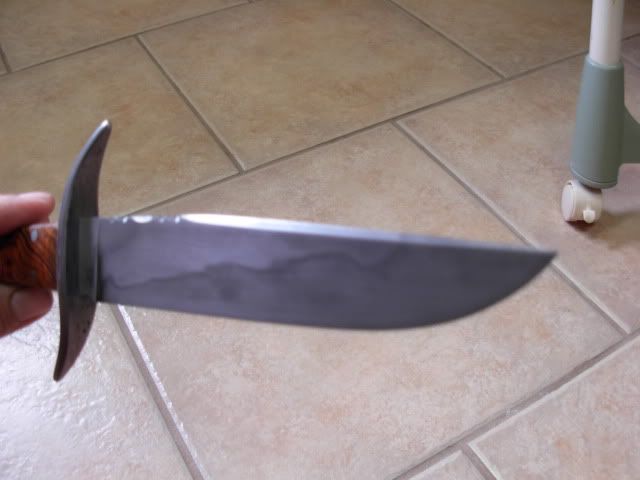Josh Dabney
Moderator
Lets start by having a look at what we're taking about here.

Lousy pic, but it does show the hamon.
Blade was ground to approx. .010 before HT. Instead of leaving extra "insurance meat" on the thickness of the blade I left it on the height leaving approx. 1/16 to be ground off after performance testing.
Ht process-
Coat blade with anti-scale wash coat.
This is not the powder kind. It is the anti-scale available from Brownells. I dillute the antiscale with hot water. Approx. a few tablespoons worth of water then dip small fantail paintbrush in the anti-scale and mix to what is still basically the consistancy of water.
Clean blade with acetone (thanks Joe Mandt for that tip) then heat with a heatgun and paint a wash over the entire warmed blade. This ends up an extremely thin coating but it's enough to prevent scale.
Put blade in Evenheat when temp reaches 1400 degrees. let come up to 1475 degrees then a 5 minute soak.
Remove and quench point down into a coffee can of canola oil.
*I am aware that this is not the ideal quench tank or meduim for 1095*
Temper 2 hours 2 times at 400 degrees.
Shapen up blank and performance test edge with chopping seasoned oak 2x4 and brass rod test the entire length of the edge several times. 2thumbs
No attemp was made at getting a Hamon on this blade at all.
This is my interpratation of what I "think" this blade is telling me.
Cross section plays a large roll in quench speed.
As is common knowledge- Canoloa oil is an insuffient quench speed for 1095 in all but the thinnest cross sections. Like 1/8" or under.
ASSUMTION- I have what is basically the same HT that I would have if I clay coated and quenched in Parks #50.
Just because this quench produced a nice and active hamon does that tell me that I have the same properties in my blade as a blade quenched in a faster medium ?
I am by no means advocating this as a proper way to HT 1095 blades and do realize that attempting to get a hamon with this method may or may not produce the desired result and little to no control over the hamon will be possible.
I bring the dead horse of 1095 quench up yet again because I was shooting for a non-differetial HT on this blade so now I'm not really sure if I'm interpreting what this blade is telling me correctly.
What it's really saying is get a proper quench tank and the Parks, LOL.
Thanks to anyone who shares an opinion on this subject !
-Josh

Lousy pic, but it does show the hamon.
Blade was ground to approx. .010 before HT. Instead of leaving extra "insurance meat" on the thickness of the blade I left it on the height leaving approx. 1/16 to be ground off after performance testing.
Ht process-
Coat blade with anti-scale wash coat.
This is not the powder kind. It is the anti-scale available from Brownells. I dillute the antiscale with hot water. Approx. a few tablespoons worth of water then dip small fantail paintbrush in the anti-scale and mix to what is still basically the consistancy of water.
Clean blade with acetone (thanks Joe Mandt for that tip) then heat with a heatgun and paint a wash over the entire warmed blade. This ends up an extremely thin coating but it's enough to prevent scale.
Put blade in Evenheat when temp reaches 1400 degrees. let come up to 1475 degrees then a 5 minute soak.
Remove and quench point down into a coffee can of canola oil.
*I am aware that this is not the ideal quench tank or meduim for 1095*
Temper 2 hours 2 times at 400 degrees.
Shapen up blank and performance test edge with chopping seasoned oak 2x4 and brass rod test the entire length of the edge several times. 2thumbs
No attemp was made at getting a Hamon on this blade at all.
This is my interpratation of what I "think" this blade is telling me.
Cross section plays a large roll in quench speed.
As is common knowledge- Canoloa oil is an insuffient quench speed for 1095 in all but the thinnest cross sections. Like 1/8" or under.
ASSUMTION- I have what is basically the same HT that I would have if I clay coated and quenched in Parks #50.
Just because this quench produced a nice and active hamon does that tell me that I have the same properties in my blade as a blade quenched in a faster medium ?
I am by no means advocating this as a proper way to HT 1095 blades and do realize that attempting to get a hamon with this method may or may not produce the desired result and little to no control over the hamon will be possible.
I bring the dead horse of 1095 quench up yet again because I was shooting for a non-differetial HT on this blade so now I'm not really sure if I'm interpreting what this blade is telling me correctly.
What it's really saying is get a proper quench tank and the Parks, LOL.
Thanks to anyone who shares an opinion on this subject !
-Josh
